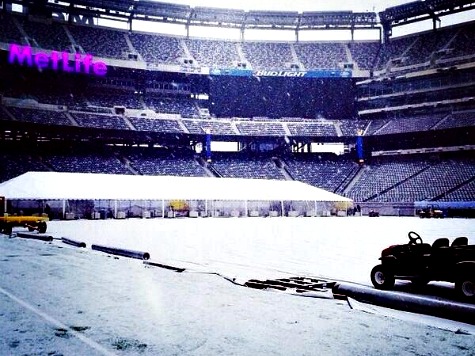“Let it Snow!” read the press release from the NFL announcing a media event at MetLife Stadium for today at 11 a.m. But with a blizzard blanketing the northeast, dropping over a foot of snow outside Philadelphia and dropping the mercury below zero in Central Massachusetts, the event may attract none but the most intrepid reporters.
Does the small press event in East Rutherford serve as foreshadowing for the enormous global event scheduled there eleven days from now?
A week-and-a-half out, the forecast calls for temperatures in the low- to mid-thirties with a chance of precipitation on Super Bowl Sunday. But when does Mother Nature behave so predictably?A blizzard bowl, as events of the last 24 hours remind, surely isn’t out of the question. The surreal spectacle of snowflakes falling could be a ratings boon or put the kaboom on Super Bowl Sunday.
Just as the game is a big gamble for bettors wagering an estimated $100 million in Las Vegas, the game is a crapshoot for the NFL, too. A league employee confirming “contingency plans” in December in case weather proves uncooperative–staging the contest a day early or late–confirms this. Should the league follow up its New Orleans black out with a New Jersey white out, the public may begin to wonder if the Super Bowl has become the Stupid Bowl.
When the San Francisco ’49ers played the Cincinnati Bengals in the first cold-climate Super Bowl in 1982, NFL commissioner Pete Rozelle had the good sense to ensure that the teams competed under a roof. Outside the Silverdome, wind chills dipped below zero and poor conditions, coupled with a poorly-timed vice presidential motorcade, made I-75 feel more like a parking lot than a highway. Team buses waited in traffic alongside tailgaters engaged in the wrong kind of tailgating. They all harbored the same worry: What if I miss the game? “Don’t worry,” ’49ers coach Bill Walsh joked to his anxious players on the bus, “Chico just threw a touchdown pass to Cosmo”–referring to equipment managers Chico Norton and George Cosmo already at the stadium.
Though Super Bowl 16 worked for ratings–its 49.1 share still stands as the NFL’s Nielsen high water mark–it didn’t work for fans traveling to Detroit. The NFL hopes the novelty of an outdoor, cold-climate Super Bowl will work for ratings, too. Will it work for ticket holders?Fans may notice that the Jersey Turnpike isn’t Bourbon Street, the Vince Lombardi rest stop isn’t Ybor City, and the Hackensack Meadowlands aren’t South Beach. The tropical, or at least lukewarm, venues that normally greet fans make the Super Bowl an event that encompasses more than the game. For this game, particularly given onerous restrictions on tailgating and the isolated nature of MetLife Stadium, the main event becomes the singular event.
The tradeoff for experiencing sports history may be experiencing weather misery. Not only will security measures and the magnitude of the event compel 83,000 to take their seats long before the opening kickoff, the Super Bowl’s elongated halftime and frequent television time-outs will make for a slow night, too. Last year’s game, including the 22-minute power outage, lasted a record-long four hours and fourteen minutes. Sitting in the open air in February works in Pasadena; northern New Jersey, not so much.
At least the players will enjoy sideline heaters, halftime shelter, and rising body temperatures from all that running, jumping, blocking, and tackling. The climate will impact the stars differently than it will the stargazers.
Geography would have fans believe cold weather would favor Denver. Style of play suggests it favors Seattle. The Seahawks, with their strong running attack and Legion of Boom defense, seem built for Buffalo or Green Bay rather than the Pacific Northwest. Denver’s high-flying pass attack, mediocre running game, and decimated defense appear less likely to exploit poor conditions should they arise. Peyton Manning’s well-documented struggles in cold weather–a 4-7 record when the thermometer dips below 32–may prove to be the most overdone Super Bowl storyline not involving Richard Sherman.
Outdoors in the northeast offers more variables, which may mean more interest. It’s a risk, but so was the original Super Bowl. In a championship game between two sovereign leagues, the NFL put its credibility on the line by embracing a challenge from its upstart AFL rival. Named after a child’s bouncing ball, the Super Bowl appropriately has traveled in unexpected directions since that initial contest in a two-thirds full Los Angeles Coliseum. Bouncing north to exit 16w on the New Jersey Turnpike is a landing spot that few anticipated.
photo: @setforward
Daniel J. Flynn, author of The War on Football: Saving America’s Game, edits Breitbart Sports.

COMMENTS
Please let us know if you're having issues with commenting.